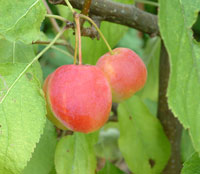
Successful wildlife gardens combine the interests of people with the needs of wildlife so let's look at some versatile shrubs that will keep us all happy.
Consider planting the native blackthorn (Prunus spinosa) with its delicate spring flowers that serve up nectar for many insects. Bodnant viburnum (Viburnum bodnantense) sports beautifully fragrant flowers which provide a rare source of winter nectar. Buddleia davidii is often called butterfly bush because butterflies simply can't resist its pretty, scented flowers. Lavender (Lavandula) has a glorious smell and provides nectar for bees, meadow brown and white butterflies, and seeds for goldfinches. The culinary herb rosemary (Rosmarinus officinalis) has a wonderful aroma and attracts hoverflies, bumblebees and honey bees.
Why not be really clever and plant firethorn (Pyracantha) or barberry (Berberis)? They display beautiful autumn colour, their thorns deter burglars and afford birds nesting protection from cats, their flowers yield nectar for insects, and their berries will be eaten by birds!
 Autumn leaf fall is very good news for animals such as ladybirds, hedgehogs and insects. They need a warm, dry place to hibernate or shelter. Consider creating a leaf pile in a quiet, sheltered corner or under evergreen shrubs.
Autumn leaf fall is very good news for animals such as ladybirds, hedgehogs and insects. They need a warm, dry place to hibernate or shelter. Consider creating a leaf pile in a quiet, sheltered corner or under evergreen shrubs. 





